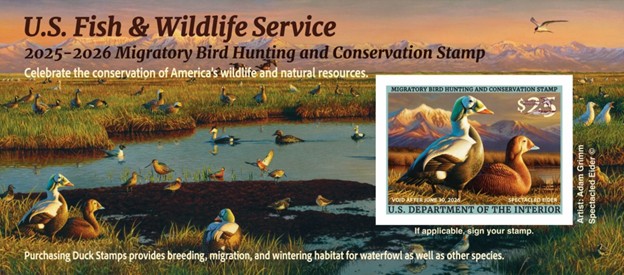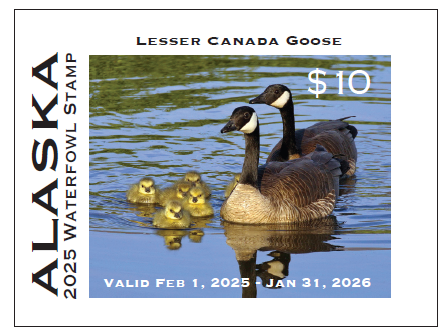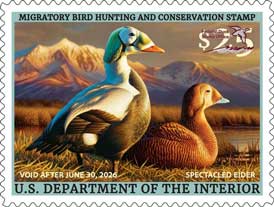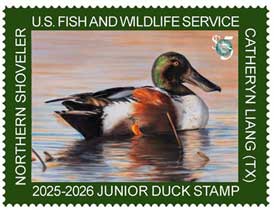Waterfowl Hunting in Alaska
License and Duck Stamp Requirements
License Requirements
Resident Hunters
All Alaska residents age 18 or older must possess a hunting license to hunt in Alaska and must carry it while hunting. Resident hunters 60 years old or older may obtain a free, permanent identification card issued by the Department. This card replaces the sport fishing, hunting, and trapping licenses. Disabled veterans qualified under AS 16.05.341 may receive a free hunting license. Residents with an annual family income equal to or less than the most recent poverty guidelines for the state may buy a $5.00 low-income license.
Nonresident and Alien Hunters
All nonresident or alien hunters, regardless of age, must possess the appropriate hunting license to hunt waterfowl.
Nonresident Military Personnel
Members of the military service on active duty who are permanently stationed in the state, and their dependents who are living in the state, and are not yet Alaska residents under AS 16.05.940(28), may buy a special nonresident military license or a non-resident small game license.
Duck Stamps
State Duck Stamp
Waterfowl hunters must purchase a current year's Alaska State Duck Stamp for all fall hunting and for those that qualify for the spring/summer subsistence hunt unless you:
- are an Alaska resident under the age of 18;
- are an Alaska resident 60 years of age or older;
- are a disabled veteran eligible for a free license;
- qualify for a low-income license; or
- are hunting only cranes and snipe.
You can purchase a state waterfowl stamp from the ADF&G online store or from a local vendor. If you have any questions about obtaining a state waterfowl stamp, please contact ADF&G Licensing at adfg.license@alaska.gov or call 907-465-2376.

Purchase the E-Duck Stamp Online! The E-Stamp was recently authorized valid for the entire hunting season (https://fws.gov/story/2024-05/taking-tradition-future-implementing-duck-stamp-modernization-act).
A federal E-stamp may be purchased at the following link: https://duckstamp.com/products, or at a local US Postal Service office.
When people purchase their 2024-2025 E-Stamp starting July 1, 2024, the E-stamp certification will be valid from the date of purchase through June 30, 2025. Additionally, those who purchase an E-stamp will be mailed their physical stamp after March 10 of the purchase year. For example, when people purchase their 2024-2025 stamp after it is issued on July 1, 2024, E-Stamp purchasers will see their actual stamps arriving after March 11, 2025. By providing the actual stamp to every customer, the Service will continue to celebrate our wildlife, wildlife art, and the talented artists participating in the Federal Duck Stamp Contest.
The E-stamp proof of purchase certification can be carried in the field either on an electronic device or as a printed hard copy depending on the individual regulations of the state they are hunting in.
If purchased using the federal website, the cost of an E-stamp will be $29.00 ($25 for the stamp, $4 for the federal processing/convenience fee). Individual states also offer the federal E-stamp but may also charge additional state fees and handling charges to any sales of E-stamps. Follow this link for a list of states that sell the E-stamp: Buy a Duck Stamp or E-Stamp | U.S. Fish & Wildlife Service (fws.gov).
The Alaska Department of Fish and Game is working to sell E-stamps through their online store in the next couple of years.

Lesser Canada Goose
The 2025 state duck stamp features a photograph by Catherine Dieh-Robbins of a lesser Canada goose (Branta canadensis parvipes; hereafter lesser[s]). Catherine is a lifelong Alaska and 30-year veteran of the Anchorage Police Department, who transitioned from capturing evidence to capturing nature's beauty. Trained in forensic and crime scene photography at the FBI Academy, Catherine spent the first half of her career running the department's photo lab. Now, she focuses on wildlife and nature photography, showcasing Alaska stunning landscapes and creatures.
Lessers are one of the three subspecies of Canada geese that breed in Alaska; nests are found in interior boreal regions of the state. They winter primarily in agriculture lands of Washington and Oregon. Lesser may be distinguished by their intermediate body size and lighter colored breast plumage. Not much is known about their biology or population status, complicating management of this subspecies. However, the Alaska Department of Fish and Game has partnered with the U.S. Fish and Wildlife Service and other state agencies to mark lesser with bands and GPS transmitters to improve our knowledge of the elusive goose.
The State Duck Stamp is valid from February 1 to January 31 the following year to encompass both the spring/summer subsistence and fall-winter hunting seasons.

Duck Stamp 2025-2026 | FWS.gov: A native of Ohio, Adam Grimm is a three-time Federal Duck Stamp artist. His 2025-2026 pair of spectacled eiders is expected to raise millions for wetland habitat conservation. In 1999, when he was only 21 years old, Adam became the youngest winner with his first Federal Duck Stamp. His second win was during the 2013 contest, and his pair of canvasback ducks graced the 2014-2015 Federal Duck Stamp. He has also won several state duck stamp contests. His artwork directly contributes to wetland habitat conservation, as proceeds from Federal Duck Stamp sales fund the National Wildlife Refuge System. Grimm combines his passion for wildlife photography and detailed artistic skills to accurately portray nature in his paintings. Now living in Wallace, South Dakota, Adam and his family enjoy wildlife photography, hunting, fishing and hiking.
Duck Stamp 2025-2026, Adam Grimm/USFWS, Copyrighted, All Rights Reserved - Used by Permission, https://www.fws.gov/media/duck-stamp-2025-2026
Federal Duck Stamp
By purchasing a Duck Stamp, you will be showing your support of bird conservation in our National Wildlife Refuge System, 98 cents of every duck stamp dollar goes directly into the Migratory Bird Conservation Fund to purchasing of vital bird habitat benefitting ducks, geese, and other migratory birds.
Federal Duck Stamp Exemption for Subsistence Hunters
A Federal Duck Stamp is not required if you are a qualified permanent rural Alaska resident or an eligible person living in an included area. Seasons when you may hunt without a federal duck stamp vary depending on how you qualify for this exemption. However, you must purchase a hunting license and state duck stamp unless you qualify for license and duck stamp exemptions listed above. For questions or clarifications, please contact the USFWS Office of Law Enforcement at (907) 786-3311.
Junior Duck Stamp
The Federal Junior Duck Stamp Conservation and Design Program is an integrated art and science curriculum developed to teach environmental science and habitat conservation. The program combines art, science, and cultural curricula to teach a greater awareness of our nation's natural and cultural resources. Participants select a species of North American waterfowl, do research on this species and its habitat, and then depict the waterfowl in an artistic medium. Students learn about conserving habitats while they explore the aesthetic qualities of wildlife and nature.

The Junior Duck Stamp Program has many benefits:
- Introduces school age children to an important and fragile part of the natural world.
- Instills a sense of individual responsibility toward the environment.
- Benefits waterfowl and their habitats as well as all migratory birds and hundreds of plants and animals that share wetland habitats.
The Junior Duck Stamp is not required to hunt waterfowl. Proceeds from the sale of the $5 stamp are re-invested into the Junior Duck Stamp Program to support conservation education and provide recognition for contest participants and winners. The Program continues to educate youth about land stewardship and the importance of connecting to their natural worlds.
For more information or to learn about and participate in this program:
